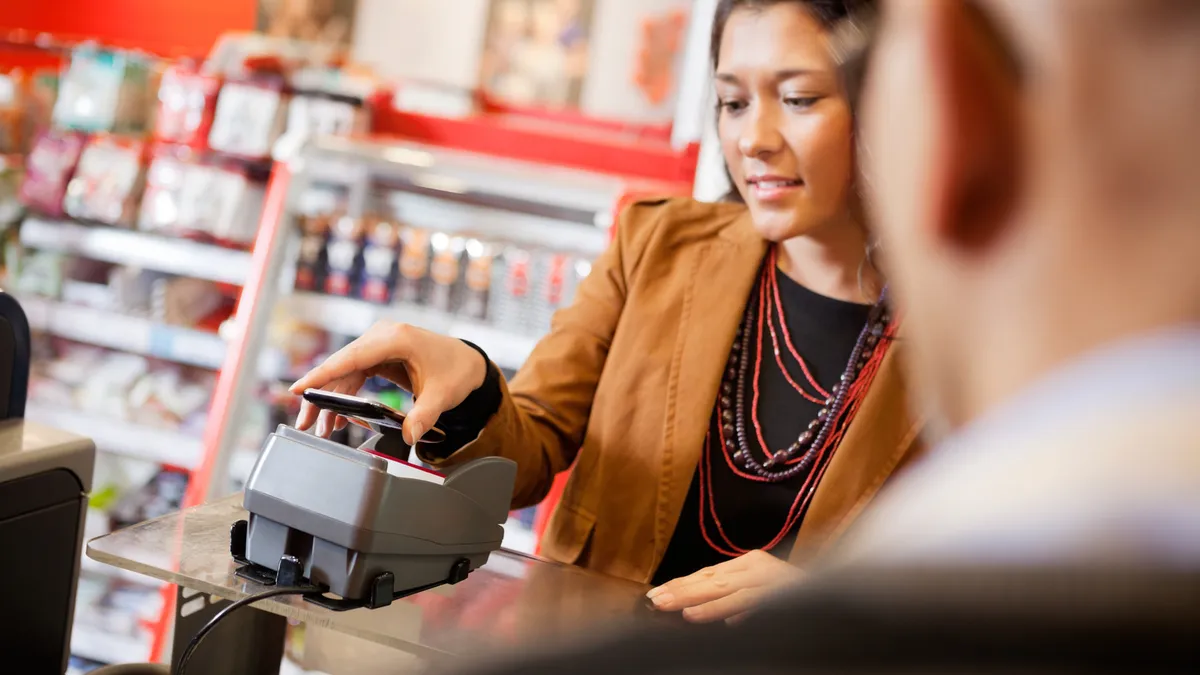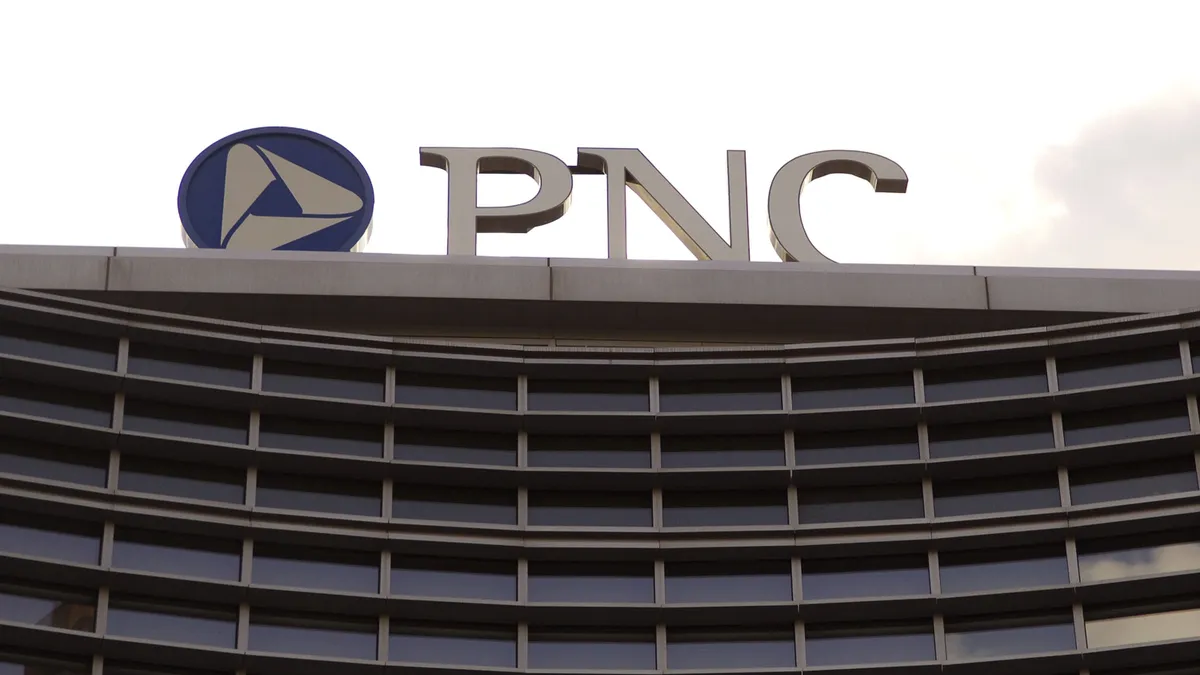A combination of barriers — ranging from legacy point-of-sale systems to learning curves on the part of consumers and businesses — has slowed the adoption of contactless payments, analysts told Industry Dive. But there remains a divide among experts as to whether the retail industry will embrace touch-and-go technology. Some anticipate retailers will integrate the technology on their own to appease customers or to address cleanliness concerns during and after the coronavirus pandemic. Others say it may take government regulation or card issuer consensus to push retailers toward the technology.
Retailers' pre-pandemic reluctance may be understandable. A report from RBR last year — before the outbreak forced physical stores to temporarily close — suggested that the average value of card-based payments would decline from $67 to $62 because contactless cards were expected to be used more frequently for low-value payments.
On the other hand, three-quarters of millennials and 70% of Gen Z shoppers said they were satisfied with contactless payments, with the latter group saying they are a "must-have" option for merchants, according to a January report from Ingenico Group and Freedom Pay.
Nathan Hilt, managing director at international consulting firm Protiviti, said he anticipates seeing contrasting data points as the outbreak continues.
An early April PYMNTS.com report found that in-store mobile wallet use hasn't gained traction with consumers, even though they have the smartphone capability to use the technology. Although nearly 93% of iPhones can use mobile wallets, Apple Pay use has declined to about 5.1% of eligible transactions from a 2017 peak, according to PYMNTS.com research. Similarly, 81% of consumers have Walmart Pay-capable devices, yet 3.3% of in-store transactions were made using Walmart Pay in the early-to-mid-March period studied in the report — a decline from a 4.5% usage rate in 2019.
In contrast, a Mastercard survey from late April found that more than half of U.S. consumers said they were using some type of contactless payments. The potential of transmitting germs at point-of-sale systems is a driving factor, with half of respondents reporting that they worry about the cleanliness of signature touchpads.
Transaction volumes are decreasing except in specific silos such as grocery stores, making it more difficult to precisely determine where the adoption of contactless payments is increasing.
Understanding mobile wallet and other contactless adoption usage requires analyzing usage from segment to segment, Hilt said.
"For the future of cards ... that path has already been taken. We're already going down it. COVID might have just accelerated it a little bit."

Cyndie Martini
President & CEO, Member Access Processing
"When you think about mobile wallets and percentages driving [it], you have to go a layer deeper," Hilt said. "Were they the same year over year in grocery? Because that's the one that's really increased. And everyone else is just a false positive."
Indeed, 85% of survey respondents said they were using their contactless cards at the grocery store, according to Mastercard's breakdown of data by location. Contactless use at transit stations ranked lowest in the breakdown, at 9%. That’s understandable, as ridership on subways and buses is down because so many people are working from home.
Younger consumers were already keen on using contactless technology. Now, older shoppers may continue to adopt the technology in earnest as they grow more comfortable shopping online and less so with in-person interactions, said Cyndie Martini, president and CEO of Member Access Processing, a financial services firm.
"I think we were already on the path for the ease of consumers, but we may see an acceleration now that people feel more confident doing online purchases without a card or the desire not to interact as much," she said. "For the future of cards ... that path has already been taken. We're already going down it. COVID might have just accelerated it a little bit."
Barriers to contactless payment adoption
For retailers that don't have contactless payment technology in place, it's unclear how an investment in how touch-and-go tech will pay off because it's hard to predict how consumer behavior will change in the long term, said Jeff Galak, associate professor of marketing at Carnegie Mellon University.
If faced with the prospect of spending hundreds of thousands or even millions of dollars to install new point-of-sale systems, retailers are likely to implement changes that they're required to make by law, but not much beyond that, Galak said.
"If they think all they need to do is put markers to make people stand six feet apart and put plexiglass to protect their workers, but they don't have to worry about point-of-sale to maintain customer loyalty, that's what they're going to do," Galak said.
U.S. fuel retailers, for example, have delayed for years the adoption of even chip-card technology. Coronavirus hardship persuaded American Express and Visa to give those retailers until April 2021 to upgrade their fuel pumps so they accept credit and debit cards with EMV chips.
Looking back on EMV chip usage, it took time to become accustomed to inserting cards rather than swiping them, Galak said. Since consumers commonly pay with cards, contactless cards might be a smoother behavioral shift than using mobile wallets, he said.
Adopting new payment options, including contactless payments, is particularly expensive for smaller businesses, because they don't get the same rates as larger companies with higher transaction volumes, Martini said.
Even in 2020, having reliable internet connectivity can be a barrier for retailers looking to add contactless payments, because unreliable internet prevents retailers from processing transactions, said Sree Singaraju, vice president of cloud solutions at Mobiquity, an international digital consulting firm.
Additionally, it takes time for retailers to train employees who may need to assist consumers in using the technology.
Pathways to adoption
A government mandate or card issuer's influence might be a catalyst toward contactless payments adoption, Singaraju said, citing Australia as an example. Westpac, one of the country's four largest banks, rolled out a three-month contactless card trial in 2012. Two years later, 60% of all Visa and Mastercard debit-card transactions were touch-and-go, according to the bank's data.
Big banks elsewhere haven't been as successful. JPMorgan Chase began issuing contactless blink cards as early as 2005. But when retailers and consumers were slow to embrace the change, it phased out the cards in 2014. The bank said in 2018 that it wanted to convert its entire card portfolio to contactless by the end of last year. Bank of America set about last year to mail contactless cards to 4 million customers in the New York, Boston and San Francisco areas. All of the cards HSBC has issued since 2015 are contactless, but it hired flash mobs as recently as last summer to encourage New York subway riders to use touch-and-go technology.
Hilt said a government mandate requiring contactless payments would be disappointing because that would mean industry likely couldn't successfully effect change on its own.
Over the next year, tech companies may begin developing and introducing application programming interfaces that can connect with mobile apps and enable smaller and midsize retailers to offer app-based contactless payments, Singaraju said. But the process won't be quick.
Retailers "are not going to be able to turn around and build out the architecture in two weeks," he said. "If you've already done that, then it's easier to provide an additional option in the mobile app."
Hilt anticipates that older consumers or late adopters may be slow to try out the technology unless it's sold to them as a way to avoid contact with a frequently touched point-of-sale terminal.
"Consumers have an expectation that merchants should be moving at the same speed they are," Martini said. "If I were a retail merchant, I would definitely be looking at new ways to take payment that kept my clients moving fast or quicker at the checkout line, because that's what people want."



















